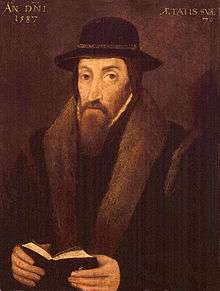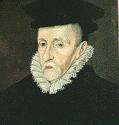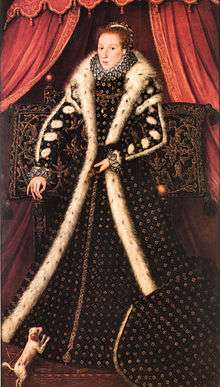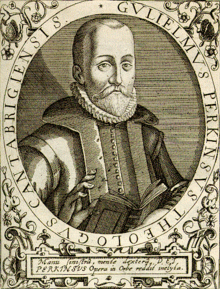History of the Puritans under Elizabeth I
The reign of Elizabeth I of England, from 1558 to 1603, saw the rise of the Puritan movement in England, its clash with the authorities of the Church of England, and its temporarily effective suppression in the 1590s by severe judicial means.
Background, to 1559
The English Reformation, begun in the reign of Henry VIII of England, was initially influenced by a number of reforming movements on the continent: Erasmian, Lutheran, and Reformed, while the practice of the Church of England continued to display many similarities with Roman Catholicism.
Evangelical reform under Edward VI
In the reign of Henry's son, Edward VI of England, the English Reformation took on a distinctly Calvinist tone. Leading Reformed churchmen sought refuge in England, including Peter Martyr Vermigli, Martin Bucer, and John a Lasco (who became head of the stranger churches). Thomas Cranmer, the primate of the Church of England, on the issue of the eucharist adopted the Reformed, rather than the Lutheran position.
Cranmer wrote his opinions into the Book of Common Prayer, which he revised several times during Edward's reign. The 1552 version, in particular, incorporated many of Martin Bucer's suggestions, as did the 1552 Forty-Two Articles. But the Church of England retained practices which had been discarded by the continental Reformed churches (including the keeping of Lent, allowing the baptism of infants by midwives, retaining the custom of the churching of women, requiring the clergy to wear vestments, and requiring kneeling at Communion).
Reign of Mary I
In 1553, Edward VI died and his Catholic half-sister assumed the throne as Mary I of England. Mary sought to end the English Reformation and restore the Church of England to full communion with the Church of Rome, and instituted repression later known as the Marian Persecutions. It saw Thomas Cranmer and other prominent English Protestants burned at the stake.
Roughly 800 English Protestants (the Marian exiles) left the country for religious reasons. Unwelcome in German Lutheran territories, they established English Protestant congregations in Emden, Wesel, Frankfurt, Strasbourg, Zurich, Basel, Geneva, and Aarau. Most of these churches continued to follow the 1552 Book of Common Prayer, but the Frankfurt congregation, under the leadership of John Knox used a liturgy drawn up by Knox, known as the Book of Common Order, according to which the clergy did not wear vestments. The Frankfurt congregation was at odds with other English Marian exiles.
The Elizabethan religious settlement, 1559
In 1558, Queen Mary died, and her half-sister, Elizabeth became Queen of England. Elizabeth had been raised as a Protestant in the household of Catherine Parr. During the first year of Elizabeth's reign many of the Marian exiles returned to England. A compromise religious position established in 1559 is now known as the Elizabethan Religious Settlement. It attempted to make England Protestant without totally alienating the portion of the population that had supported Catholicism under Mary. The settlement was consolidated in 1563. An interim position of 11 articles of faith operated for a few years.[1]
The Church of England under Elizabeth was broadly Reformed in nature: Elizabeth's first Archbishop of Canterbury, Matthew Parker had been the executor of Martin Bucer's will, and his replacement, Edmund Grindal had carried the coffin at Bucer's funeral. While the Elizabethan Settlement proved generally acceptable, there remained minorities who were dissatisfied with the state of the Church of England. The cry for "further reform" in the 1560s was the basis of what is now known as the Puritan Movement
During the 1560s and 1570s, the works of John Calvin were the most widely disseminated publications in England, while the works of Theodore Beza also enjoyed popularity. The bishops who opposed Puritanism in the 16th and early 17th century were themselves Calvinists. It was only later that doctrinal Calvinism came to be particularly associated with Puritanism.
Archiepiscopate of Matthew Parker, 1559–1575

Convocation of 1562/3
The Convocation of 1563 restored the position of the Thirty-Nine Articles in the Church of England (more accurately said, the Forty-Two Articles of Edward VI were reduced to a draft at this point, which was widely supported, and eventually enforced after 1571). There were further proposals from reformers, in particular on canon law and liturgy, some of which originated from a group among the bishops. These, however, proved contentious, and did not pass. Subsequent contestation of the same matters made some of the issues a matter of authority.[2]
Convocation opened on 15 January 1562/3 with a sermon by William Day; he was one of leaders, prominent with Alexander Nowell (who had preached the day before at the opening of Parliament) and Thomas Sampson, of the reformers.[3][4][5] Further reforms put forward included: 1) a reduction in the number of saints' days; 2) the elimination of vestments; 3) the elimination of kneeling at communion; 4) the elimination of "emergency baptism" of sickly newborns; and 5) the elimination of organs from churches. The emerging "Puritan" faction achieved nothing in the direction of such goals at the 1563 Convocation. Some of the clergy introduced these reforms in their congregations on their own initiative, in the following years. For example, at Cambridge, William Fulke convinced his students not to wear their surplices and to hiss at students who did. In this situation, Archbishop Parker published a set of Advertisements, requiring uniformity in clerical dress.
Vestiarian Controversy, 1563–1569
The Puritan faction objected loudly, and appealed to the continental reformers to support their cause. Unfortunately for the Puritans many of the continental reformers felt that the Puritans were just making trouble - for example, in a letter to Bishop Grindal, Heinrich Bullinger accused the Puritans of displaying "a contentious spirit under the name of conscience". Grindal proceeded to publish the letter without Bullinger's permission. Theodore Beza was more supportive of the Puritan position, though he did not intervene too loudly because he feared angering the queen and he wanted the queen to intervene in France on behalf of the Huguenots. In response to clergymen refusing to wear their vestments, 37 ministers were suspended. In response, in 1569, some ministers began holding their own services, the first example of Puritan separatism.
The Admonition to the Parliament (1572) and the demand for Presbyterianism
Throughout the 1560s, England's return to Protestantism remained tentative, and large numbers of the people were committed to and sought a return to Catholicism. Three related events around 1570 led to a reinforcement of Protestantism in England: (1) The Rising of the North, when the northern earls revolted, demanding a return to Catholicism; (2) Pope Pius V issued the bull Regnans in Excelsis, absolving Catholics of their duty of allegiance to Elizabeth; and (3) the Ridolfi plot sought to replace Elizabeth with the Catholic Mary, Queen of Scots. In response to this Catholic rebelliousness, the English government took several measures to shore up the Protestantism of the regime: (1) all clergymen were required to subscribe to the Thirty-Nine Articles; (2) all laity were required to take communion according to the rite of the Book of Common Prayer in their home parish at least once a year; and (3) it became a treasonable offence to say that the queen was a heretic or a schismatic.

In this pro-Protestant, anti-Catholic environment, the Puritan faction sought to push further reforms on the Church of England. John Foxe and Thomas Norton presented a reform proposal initially drawn up under Edward VI to Parliament. Elizabeth quickly dismissed this proposal, however, insisting on adherence to the 1559 religious settlement. Meanwhile, at Cambridge, professor Thomas Cartwright, a long-time opponent of vestments, offered a series of lectures in 1570 on the Book of Acts in which he called for the abolition of episcopacy and the creation of a presbyterian system of church governance in England.
Puritans were further dismayed when they learned that the bishops had decided to merge the vestarian controversy into the requirement that clergy subscribe to the Thirty-Nine Articles: at the time they swore their allegiance to the Thirty-Nine Articles, the bishops also required all clergymen to swear that the use of the Book of Common Prayer and the wearing of vestments are not contrary to Scripture. Many of the Puritan clergymen were incensed at this requirement. A bill authorizing the bishops to permit deviations from the Book of Common Prayer in cases where the Prayer Book required something contrary to a clergyman's conscience was presented and defeated at the next parliament.
Meanwhile, at Cambridge, Vice-Chancellor John Whitgift moved against Thomas Cartwright, depriving Cartwright of his professorship and his fellowship in 1571.
Under these circumstances, in 1572, two London clergymen – Thomas Wilcox and John Field – penned the first classic expression of Puritanism, their Admonition to the Parliament. According to the Admonition, the Puritans had long accepted the Book of Common Prayer, with all its deficiencies, because it promoted the peace and unity of the church.

However, now that the bishops required them to subscribe to the Book of Common Prayer, the Puritans felt obliged to point out the popery and superstition contained in the Prayer Book. The Admonition went on to call for more thorough church reforms, modelled on the reforms made by the Huguenots or by the Church of Scotland under the leadership of John Knox. The Admonition ended by denouncing the bishops and calling for the replacement of episcopalianism with presbyterianism.
The Admonition to Parliament set off a major controversy in England. John Whitgift wrote an Answer denouncing the Admonition, which in turn led to Thomas Cartwright's Replye to An Answere Made of M. Doctor Whitgift Agaynste the Admonition to the Parliament (1573), a second Puritan classic. Cartwright argued that a properly reformed church must contain the four orders of ministers identified by Calvin: teaching elders, ruling elders, deacons and theological professors. Cartwright went on to denounce the subjection of any minister in the church to any other minister in the strongest possible terms. In a Second Replye, Cartwright was even more forceful, arguing that any pre-eminence accorded to any minister in the church violated divine law. Furthermore, he went on to assert that a presbyterian hierarchy of presbyteries and synods was required by divine law.
In 1574, Walter Travers, an ally of Cartwright, published a Full and Plaine Declaration of Ecclesiasticall Discipline, setting forth a scheme of reform in greater detail than Cartwright had.
The government moved against all three of these Puritan leaders: John Field and Thomas Wilcox were imprisoned for a year, while Thomas Cartwright fled to exile on the continent to avoid such a fate. In the end, however, the number of clergymen who refused to subscribe to the bishops' requirements proved to be too large, and a number of qualified subscriptions were allowed.
Archiepiscopate of Edmund Grindal, 1575–1583
The reign of Edmund Grindal as Archbishop of Canterbury (1575–1583) was relatively tranquil compared with that of his predecessor. The major issue came in 1581, when Robert Browne and his congregation at Bury St Edmunds withdrew from communion in the Church of England, citing the Church of England's dumb (i.e. non-preaching) ministry, and the lack of proper church discipline. Browne and his followers, known as the Brownists, were forced into exile in the Low Countries. There, they were encouraged by Thomas Cartwright, who was now serving as minister to the Merchant Adventurers at Middelburg. Cartwright, however, opposed separatism). Like most Puritans, he advocated further reforms to the Church of England from within.
A second Puritan development under Grindal was the rise of the Puritan conventicle, modelled on the Zurich Prophezei (Puritans learned of the practice through the congregation of refugees from Zurich established in London), where ministers met weekly to discuss "profitable questions". These "profitable questions" included the correct use of Sabbath, an initial sign of the Sabbatarianism of the English Puritans. The queen objected to the growth of the conventicling movement and ordered Archbishop Grindal to suppress. When Grindal refused, citing I Cor. 14, he was disgraced and placed under virtual house arrest for the rest of his tenure as Archbishop. The conventicles resumed after a brief period of suspension.
Archiepiscopate of John Whitgift, 1583–1604
John Whitgift had been a vocal opponent of Thomas Cartwright. He believed that the matter of church governance was adiaphora, a "matter indifferent", and that the church should accommodate with the state in which the church was located. The Church of England was located in a monarchy, so the church should adopt an episcopal style of government.
Renewed calls for Presbyterianism

The years 1583-1585 saw the brief ascendancy in Scotland of James Stewart, who claimed the title of Earl of Arran. This period saw Scotland pass the Black Acts, which outlawed the Second Book of Discipline. As a response, many Scottish ministers, including Andrew Melville, sought refuge in England. These refugees participated in the English conventicles (as did John Field, now released from prison) and convinced many English Puritans that they should renew their fight to establish presbyterianism in England. As such, in the 1584 Parliament, Puritans introduced legislation to replace the Book of Common Prayer with the Genevan Book of Order and to introduce presbyterianism. This effort failed.
At this point, John Field, Walter Travers, and Thomas Cartwright were all free and back in England and determined to draft a new order for the Church of England. They drafted a Book of Discipline, which circulated in 1586, and which they hoped would be accepted by the 1586 Parliament. Again, the Puritan effort failed in Parliament.
Martin Marprelate, 1588–89, and response
In 1588–89, a series of virulently anti-episcopal tracts were published under the pseudonym of Martin Marprelate. These Marprelate tracts, likely published by Job Throckmorton and Welsh publisher John Penry, denounced the bishops as agents of Antichrist, the strongest possible denunciation for Christians. The Marprelate tracts called the bishops "our vile servile dunghill ministers of damnation, that viperous generation, those scorpions."
Unfortunately for the Puritans, the mid- to late-1580s saw a number of the defenders of the Puritans in the English government die: Francis Russell, 2nd Earl of Bedford in 1585; Robert Dudley, 1st Earl of Leicester in 1588; and Francis Walsingham in 1590. In these circumstances, Richard Bancroft (John Whitgift's chaplain) led a crackdown against the Puritans. Cartwright and eight other Puritan leaders were imprisoned for eighteen months, before facing trial in the Star Chamber. The conventicles were disbanded.
Some Puritans followed Robert Browne's lead and withdrew from the Church of England. A number of those separatists were arrested in the woods near Islington in 1593, and John Greenwood and Henry Barrowe were executed for advocating separatism. Followers of Greenwood and Barrowe fled to the Netherlands, and would form the basis of the Pilgrims, who would later found the Plymouth Colony.
1593 also saw the English parliament pass the Religion Act (35 Elizabeth c. 1) and the Popish Recusants Act (35 Elizabeth c. 2), which provided that those worshipping outside the Church of England had three months in which to either conform to the Church of England or else abjure the realm, forfeiting their lands and goods to the crown, with failure to abjure being a capital offence. Although these acts were directed against Roman Catholics who refused to conform to the Church of England, on their face they also applied to many of the Puritans. Although no Puritans were executed under these laws, they remained a constant threat and source of anxiety to the Puritans.
The drive to create a preaching ministry

One of the most important aspects of the Puritan movement was its insistence on having a preaching ministry throughout the country. At the time of the Elizabethan Religious Settlement, less than 10 per cent of the 40,000 English parish clergy was licensed to preach. (Since the time of the repression of the Lollards in the 14th century, it had been illegal for an ordained parish priest to preach to his congregation without first obtaining a licence from his bishop.) Elizabeth herself had been no fan of preaching and preferred a church service focused on the Prayer Book liturgy. However, many of Elizabeth's bishops did support the development of a preaching ministry and, aided by wealthy laymen, were able to dramatically expand the number of qualified preachers in the country. For example, Sir Walter Mildmay founded Emmanuel College, Cambridge in 1584 to promote the training of preaching ministers. Frances Sidney, Countess of Sussex similarly founded Sidney Sussex College, Cambridge in 1596. Emmanuel and Sidney Sussex became the homes of academic Puritanism.

Although the number of preachers increased dramatically over the course of Elizabeth's reign, there were still insufficient preachers in the country. A layman who wanted to hear a sermon might have to travel to another parish in order to find one with a preaching minister. When he got there, he might find that the preaching minister had shortened the Prayer Book service to allow more time for preaching. And, as a trained minister, when he did pray, he was more likely to offer an extemporaneous prayer instead of simply reading the set prayer out of the Prayer Book. Thus we see two different styles developing in the Church of England: a traditional style, focused on the liturgy of the Book of Common Prayer; and the Puritan style, focused on preaching, with less ceremony and shorter or extemporaneous prayers.
The rise of "experimental predestinarianism"
Following the suppression of Puritanism in the wake of the Marprelate Tracts, Puritans in England assumed a more low-key approach in the 1590s. Ministers who favoured further reforms increasingly turned their attention away from structural reforms to the Church of England, instead choosing to focus on individual, personal holiness. Theologians such as William Perkins of Cambridge continued to maintain the rigorously high standards of previous Puritans, but now focused their attention on improving individual, as opposed to collective, righteousness. A characteristic Puritan focus during this period was for more rigorous keeping of the Christian Sabbath. William Perkins is also credited with introducing Theodore Beza's version of double predestination to the English Puritans, a view which he popularized through the use of a chart he created known as "The Golden Chain".

In 1970, R. T. Kendall labelled the form of religion practised by William Perkins and his followers as experimental predestinarianism, a position that Kendall contrasted with credal predestinarianism.[6] Kendall identified credal predestinarians as anyone who accepted the Calvinist teaching on predestination. Experimental predestinarians, however, went beyond merely adhering to the doctrine of predestination, teaching that it was possible for individuals to know experimentally that they were saved and a member of God's elect predestined for eternal life. (The credal predestinarians believed that only some group were destined for eternal life, but that it was impossible in this life to identify who was elect and who was reprobate.) Puritans who adopted Perkins' brand of experimental predestinarianism felt obliged, once they had undergone a religious process to attain knowledge of their election, to seek out like-minded individuals who had undergone similar religious experiences.
In time, some Puritan clergymen and laity, who increasingly referred to themselves as "the godly", began to view themselves as distinct from the regular members of the Church of England, who had not undergone an emotional conversion experience. At times, this tendency led for calls for "the godly" to separate themselves from the Church of England. While the majority of Puritans remained "non-separating Puritans", they nevertheless came to constitute a distinct social group within the Church of England by the turn of the 17th century. In the next reign, "the Puritan" as a type was common enough that playwright Ben Jonson could satirize Puritans in the form of the characters Tribulation and Ananais in The Alchemist (1610) and Zeal-of-the-land Busy in Bartholomew Fair (1614).
Notes
- ↑ Thomas Lathbury (1853). History of the Convocation of the Church of England. p. 163. Retrieved 21 November 2012.
- ↑ Felicity Heal (2005). Reformation in Britain and Ireland. Oxford University Press. p. 362. ISBN 978-0-19-928015-5. Retrieved 21 November 2012.
- ↑ Usher, Brett. "Day, William". Oxford Dictionary of National Biography (online ed.). Oxford University Press. doi:10.1093/ref:odnb/7373. (Subscription or UK public library membership required.)
- ↑ Lehmberg, Stanford. "Nowell, Alexander". Oxford Dictionary of National Biography (online ed.). Oxford University Press. doi:10.1093/ref:odnb/20378. (Subscription or UK public library membership required.)
- ↑ Ryrie, Alec. "Sampson, Thomas". Oxford Dictionary of National Biography (online ed.). Oxford University Press. doi:10.1093/ref:odnb/24595. (Subscription or UK public library membership required.)
- ↑ R. T. Kendall (1970). Calvin and English Calvinism.
